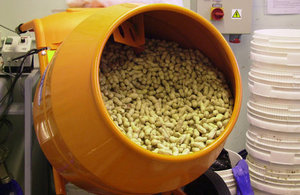GC team verifies sampling procedure to detect carcinogenic toxins
Government Chemist team has carried out research work to verify that sampling procedures ensure the detection of cancer causing toxins

Bulk sample mixing using a cement mixer (courtesy Kent Scientific Services and Kirstin Gray)
Why aflatoxins are dangerous and challenges in detection
The Government Chemist is required to act as the national focus of technical appeal in specified areas where there is an actual or potential dispute between food businesses and regulators on the results of chemical analysis or their interpretation.
Many such disputes have involved aflatoxins, which are toxins generated by moulds that can cause cancer. Port Health Authorities safeguard the food supply coming into the UK by sampling large consignments of food for aflatoxin testing by Public Analysts. However, mould growth is notoriously patchy – so how good is the sampling and does it really protect us from these toxins?
What we have done to help
The Government Chemist team investigated the effectiveness of the current sampling protocol, which sees multiple increments taken and aggregated to form a sample up to 30 kg in size. The sample is then reduced to manageable proportions for testing by statistically controlled sub-sampling and high speed mixing with water.
In this study, six replicate sampling exercises were carried out on a 1.5 tonne cargo of groundnuts (peanuts) known to be contaminated by the toxin-producing mould. The results confirmed that when carried out properly, the elaborate sampling was able to spot the contamination each time.
The full report is available in an open access scientific paper.
The lead author of the paper, Dr Michael Walker, said:
Importers and Port Health officials work hard together to ensure food brought into the UK is safe to eat by lengthy and painstaking sampling. It is important to be sure this costly work is effective and I am pleased our findings bore this out.
The Government Chemist team would like to acknowledge the kind assistance of Prof Duncan Thorburn Burns, Institute of Global Food Security, Queen’s University, Belfast, in the publication of this work.